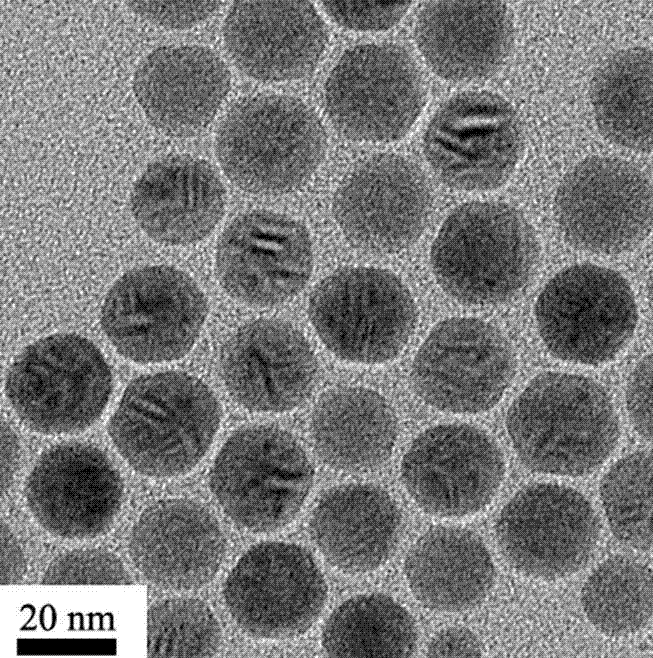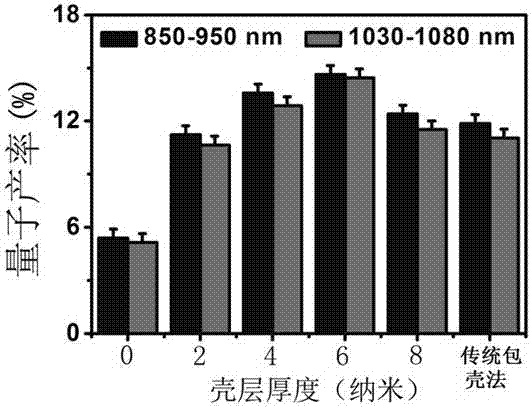High-efficient anti-quenching neodymium-doped rare earth infrared fluorescent probe and synthetic method thereof
A fluorescent probe, neodymium-doped technology, applied in the direction of fluorescence/phosphorescence, chemical instruments and methods, luminescent materials, etc., can solve the problems of reducing fluorescence intensity, achieve high fluorescence quantum yield, and improve the down-conversion fluorescence quantum of neodymium The effect of yield and fluorescence stability, strong anti-fade effect
- Summary
- Abstract
- Description
- Claims
- Application Information
AI Technical Summary
Problems solved by technology
Method used
Image
Examples
Example Embodiment
[0020] Example 1:
[0021] (1) Preparation of the shell precursor. Preparation of Gd-OA (0.1 M) precursor: Take a 50 mL three-necked round bottom flask as a reaction vessel, and add 2.5 mmol GdCl in sequence 3 , 10 mL oleic acid (OA), 15 mL octadecene (ODE). Under vacuum and magnetic stirring conditions, it was heated to 140 degrees Celsius and kept for 1 hour, and finally a clear and transparent Gd-OA (0.1 M) precursor was obtained.
[0022] Preparation of Na-TFA-OA precursor: Take a 25 mL three-necked round bottom flask as a reaction vessel, add 4 mmol sodium trifluoroacetate and 10 mL oleic acid successively, and dissolve at room temperature under vacuum and stirring conditions to obtain a colorless, transparent and clear Na-TFA-OA precursor solution.
[0023] (2) Synthesis of down-conversion luminous core. Take a 50 mL three-necked round bottom flask as the reaction vessel, and first add 0.95 mmol GdCl 3 , 0.5 mmol NdCl 3 Then add 6 mL oleic acid (OA) and 15 mL octadecene (OD...
Example Embodiment
[0026] Example 2: The surface of the neodymium-doped rare earth core-shell structure nanocrystals prepared in Example 1 with high efficiency and anti-quenching is hydrophobic, and the obtained nanocrystals can be made water-soluble by modifying them with amphiphilic molecules, so that they have better properties. Biocompatibility. Through fluorescence spectroscopy, we found that the core-shell structured nanocrystals synthesized by the continuous layer-by-layer growth method have higher anti-quenching effect than the core-shell structured nanocrystals synthesized by the traditional cladding method, and when the encapsulated shell layer The thicker, the stronger the anti-quenching effect.
PUM
 Login to View More
Login to View More Abstract
Description
Claims
Application Information
 Login to View More
Login to View More - R&D
- Intellectual Property
- Life Sciences
- Materials
- Tech Scout
- Unparalleled Data Quality
- Higher Quality Content
- 60% Fewer Hallucinations
Browse by: Latest US Patents, China's latest patents, Technical Efficacy Thesaurus, Application Domain, Technology Topic, Popular Technical Reports.
© 2025 PatSnap. All rights reserved.Legal|Privacy policy|Modern Slavery Act Transparency Statement|Sitemap|About US| Contact US: help@patsnap.com



